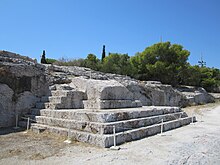Πνύκα | |
 Pnyx speaker's platform | |
Location of the Pnyx on a map of Athens | |
| Location | Athens, Greece |
|---|---|
| Region | Attica |
| Coordinates | 37°58′18″N 23°43′10″E / 37.971667°N 23.719444°E |
| History | |
| Founded | 507 BC |
| Periods | Fifth-century Athens |
| Cultures | Ancient Greece |
| Site notes | |
| Condition | Ruined |
| Ownership | Public property |
| Management | Ministry of Culture |
| Public access | No |
The Pnyx (/nɪks, pəˈnɪks/; Ancient Greek: Πνύξ [pnýks]; Greek: Πνύκα, Pnyka) is a hill or hillside in central Athens, the capital of Greece. Beginning as early as 507 BC (Fifth-century Athens), the Athenians gathered on the Pnyx to host their popular assemblies, thus making the hill one of the earliest and most important sites in the creation of democracy.
The Pnyx is located less than 1 kilometre (0.62 mi) west of the Acropolis and about 2 km south-west of the Syntagma Square in the centre of Athens. The "mainly natural hollow" was first used from before 500 BC to perhaps 404 BC, when the arrangement was changed by adding a retaining wall below the speakers' platform, with the space between filled with earth.[1]
The Pnyx was probably the prototype for the Greek theatre auditorium, with the late form perhaps reflecting changes in theatre design.[2]
